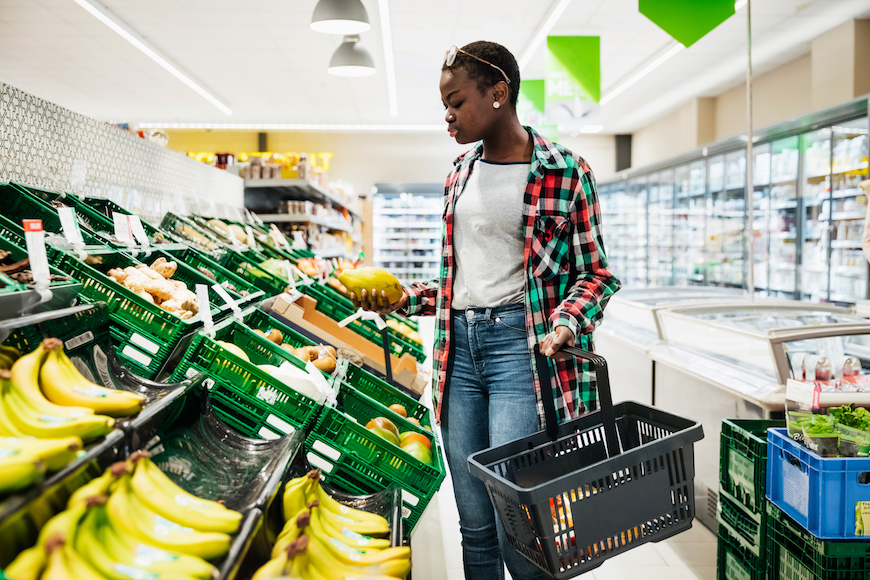
January 31, 2020 at 12:00AM by CWC
With everyone finally waking up to the realities of the climate crisis, it’s safe to say that many healthy eaters are wondering how they can help our current state of affairs. For some people, that might mean cutting back on meat. For others, that might mean signing up for a CSA to reduce their food’s carbon footprint and support local industry, or paying renewed effort to their food wasting habits. But beyond using reusable tote bags at Whole Foods, our grocery shopping habits don’t always get a ton of scrutiny for their environmental impact.
However, just like bringing your own bags to the grocery store and farmer’s market, there are other super simple changes that can easily become automatic, while being big wins on the sustainability front. The key is knowing what they are. To that end, we asked some sustainability experts to share tips on how to tweak our current grocery shopping behaviors to be better for the planet—without totally overhauling how or what we eat.
6 simple changes for more sustainable food shopping
1. bring your own produce bags
Some states have already banned plastic bag use—or are charging extra for them—but the little plastic bags in the produce section remain a staple. “To cut down on plastic, don’t buy pre-wrapped fruits or vegetables, and bring your own reusable produce bags,” says registered dietitian Diana Rodgers, RD, creator of Sustainable Dish and author of the upcoming book, Sacred Cow. Reusable produce bags are easy to find on Amazon, made of nylon or cotton.
2. buy in-season fish
ADVERTISEMENT
ADVERTISEMENTKate Spade Autumn/Winter Sale |
We all know the merits of buying local, in-season produce, but there are other types of food that have a seasonal rhythm that impacts price and freshness. “We don’t tend to think of fish as a seasonal food, but they are,” says Maria Marlowe, a certified health coach and author of The Real Food Grocery Guide. “Water temperature varies by season and spawning takes place at certain times of the year, causing fish to migrate with the seasons.” Plus, fish caught during spawning seasons weren’t able to reproduce or are immature, which will affect the availability of those species in the future.
One way to check to see what types of fish are not only in-season but aren’t being overfished is to check Monterey Bay Aquarium’s Seafood Watch app, something both Rodgers and Marlowe recommend. “It shows the most sustainable choices for over 150 types of fish. They also flag seafood that contain levels of mercury or PCBs that pose a health risk,” Marlowe says.
3. Prioritize locally-grown meat and experiment with unusual cuts
When it comes to being a mindful meat eater, both Rodgers and Marlowe say that buying local, grass-fed, pasture-raised meat whenever possible is the most sustainable way to go. That way, you’re ensuring that the animal was raised ethically, in an environmentally-responsible way, and wasn’t shipped long distances in order to be sold in your grocery store. “For the fully committed, you can do an animal share, where you ‘buy a share’ in one animal,” Marlowe says. “You’ll need a separate freezer for this as you’ll get all the frozen meat at once, which lasts about six months to a year.”
If that’s not an option for your household, a smaller change to make, Marlowe says, is experimenting with cuts that are often looked over and discarded—which combats food waste. “You can sometimes purchase less popular parts of the animal from the butcher, like organ meats, which happen to be highly nutritious,” she says. Ask the butcher behind the counter for suggestions on how to cook unfamiliar cuts.
Looking for more tips on eating sustainably? Check out these picks from an RD:
4. buy dry goods in bulk
According to Marlowe, buying dry goods such as dried lentils, beans, nuts, and seeds, in bulk is not only more sustainable, it’s more cost-effective, too. “There’s no spoilage and you cut down on packaging,” she says. “Some health food stores even provide glass containers for bulk foods, or paper bags instead of plastic.”
5. Choose foods in glass containers, not plastic packaging, when possible
When it comes to sustainable grocery shopping, packaging matters. “Choose glass packaging when you can, and be sure to recycle,” Marlowe says. (Just remember to fully rinse products and remove the lids when recycling them.) Increasingly, many health food stores and grocery stores are allowing customers to bring in glass jars for bulk items and even almond milk—another way to shop more sustainably, if it’s an option for you.
6. buy less, more frequently
To cut down on food waste, Marlowe says one way to shop more sustainably is buying less food more often instead of doing big grocery trips once in a while. That way, you won’t end up throwing out produce, meat, or other foods that go bad before you have a chance to use them.
When it comes to sustainable food shopping, the biggest hurdle is shifting your mindset to think more about where the food you’re buying is coming from. But once put into practice, it hardly requires any effort at all.
Another way to be more sustainable: cooking with food scraps. And BTW, being a sustainable eater doesn’t have to be expensive.
Author Emily Laurence | Well and Good
Selected by CWC
ADVERTISEMENT
ADVERTISEMENTSports Direct Free Delivery on All Orders! |

ADVERTISEMENT
ADVERTISEMENTUp to 30% off Gift Sets |






